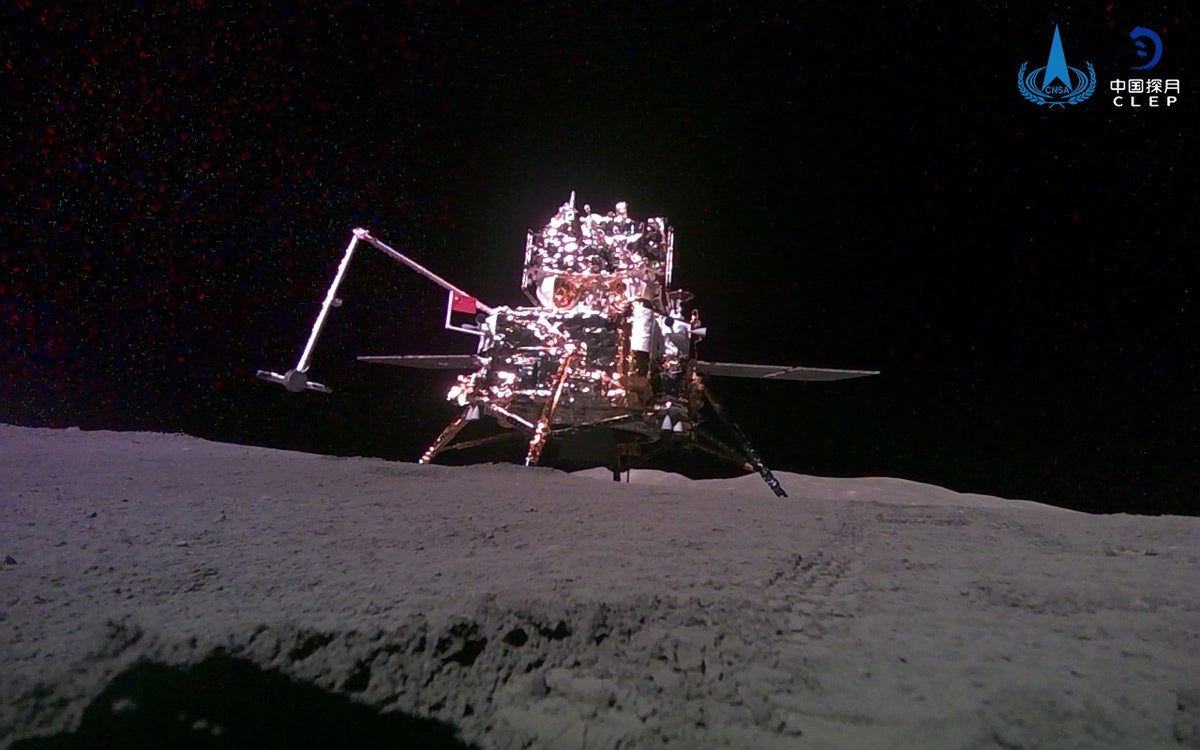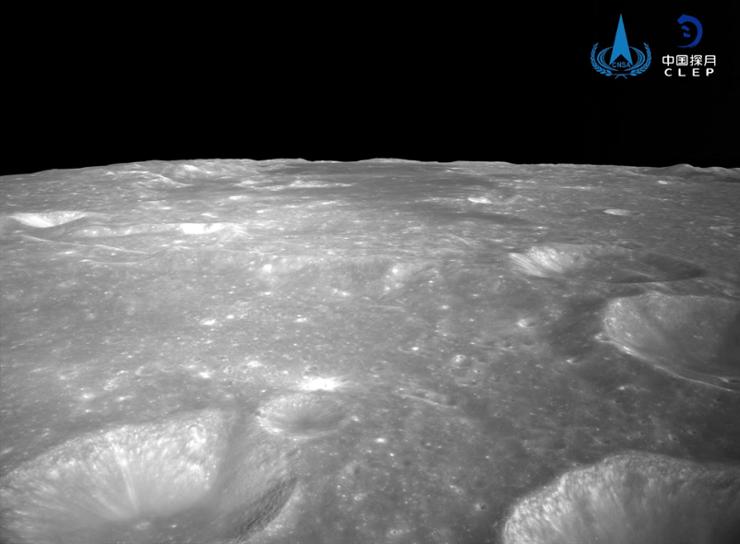The robotic mission marks a historic first for China and could help unravel the mysteries of the Moon's formation.

The Chang'e 6 lander sits on the Moon in this image taken by the Jinchan mini-rover. Credit: CNSA
On June 25, 2024, China’s Chang’e 6 mission came to an end when a reentry capsule landed in Mongolia’s Siziwang Banner Province. The capsule contained a truly precious cargo: just under 2 kilograms (4.4 lb) of lunar samples from the far side of the Moon. No mission had ever recovered material from the far side of the Moon before, giving China a historic milestone and boosting its lunar program.
China’s lunar program, which began modestly 20 years ago, has slowly grown into a giant of research and technological innovation, watched with a degree of caution by NASA, Japan, and the European Space Agency. Unlike NASA, which is a civilian agency, China’s space program is closely linked to, and to some extent integrated with, its national military forces. The program, which began with lunar orbiters and progressed to lunar landers and rovers, has now reached the point of being able to mount a series of sample return missions of remarkable complexity. The Chang’e 6 mission follows the successful Chang’e 5 mission in 2020, which brought back samples from the near side of the Moon.
Chang'e's Epic Journey 6

Chang'e 6 was launched on May 3 of this year aboard a Long March 5 heavy-lift rocket —China’s equivalent of a Delta 4 or Falcon 9 rocket—and then went through several discrete phases. On May 8, it entered a highly elliptical lunar orbit (124 by 236,000 miles (200 by 380,000 kilometers) and spent about 20 days mapping the lunar surface in search of an acceptable landing site while at the same time slowly circularizing its orbit.
On June 1, the lander and ascent stage separated from the orbiter and, after a 15-minute descent, autonomously touched down on the far side of the Moon. The lander was able to obtain samples of the lunar surface and core, while being photographed by a mini-rover it had brought to the surface. The mini-rover, known as Jinchan and weighing just 5 kilograms, was released to move a few meters away from the lander and captured some truly stunning images of the main lander, resting on the lunar surface with a Chinese flag flying.
Related: Exploring the Moon: China's Chang'e missions
Once secured, the samples lifted off from the lunar surface aboard the ascension module, which the Chinese call an “ascendant.” The ascender deployed solar panels and made multiple adjustments to its orbit around the Moon before rendezvousing with the orbiter. Once the delicate rendezvous and docking was complete, the lunar samples were transferred internally to the so-called return module. Once this was complete, the ascender was discarded. The orbiter and return module orbited the Moon for about 14 more days until the right window opened for a return to Earth. At this point, the orbiter/returner complex fired its engine and headed for home.
At about 5,000 kilometers from Earth, the return module detached and began its reentry. Looking much like a miniature Soyuz descent module, the return module performed a non-ballistic reentry, also known as a skip reentry. This allowed it to burn off speed and dissipate energy as it entered and exited the atmosphere before making its final descent to the surface for a soft landing under a parachute. Recovery forces quickly caught up with the return module after touchdown.
A coveted scientific prize
The samples were flown to the China Academy of Space Technology in Beijing and, after a brief ceremony, handed over to the scientists. The far side of the Moon is of particular interest to lunar scientists because it is distinctly different from the near side, which is dominated by volcanic plains known as maria. The near side is abundantly covered by maria, while the far side has virtually none. The reasons for this disparity between the near and far sides of the Moon are currently a matter of debate. Rocks on the far side of the Moon also have a different chemical composition than those on the near side. Scientists hope that samples brought back by the Chang'e 6 mission will resolve some of these discrepancies.
As in the past, Chinese scientists will have the first chance to study the returned samples. It may be years before China allows international researchers to request access to them; the samples recovered by Chang’e 5 in December 2020 were not offered to international labs until August 2023, and NASA did not give its scientists the green light to request them until December of that year. (Under U.S. law, NASA is prohibited from collaborating bilaterally with China; to obtain an exception, the agency had to certify to Congress that there was no technology transfer or security risk in studying lunar rocks.)
The success of the Chang'e 6 mission puts China one step closer to its ultimate goal: putting Chinese astronauts (“taikonauts”) on the Moon. China plans to one day have a lunar outpost near the south pole and hopes to conduct a crewed landing by 2030. While NASA administrators are eager to assert that they are not in a space race with China, the United States is seeking to send astronauts back to the Moon through the Artemis program before China conducts its own first landing, and the two space agencies are clearly keeping an eye on each other. Time will tell who will set foot on the Moon next.








Leave feedback about this